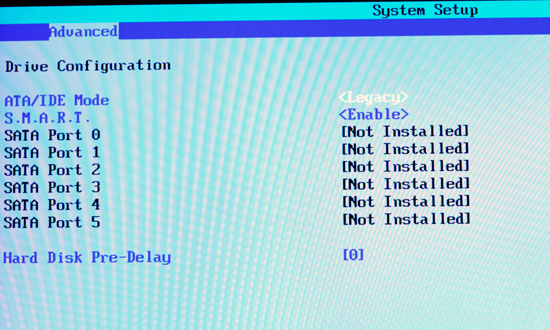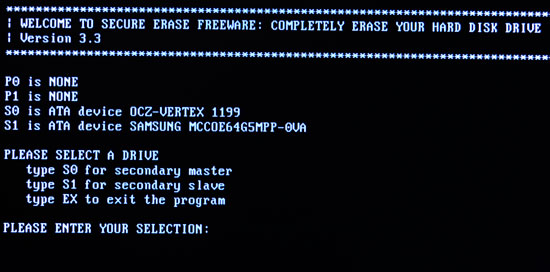The SSD Anthology: Understanding SSDs and New Drives from OCZ
by Anand Lal Shimpi on March 18, 2009 12:00 AM EST- Posted in
- Storage
Restoring Your Drive to Peak Performance
Based on my explanation there’s one sure-fire way to make your drive fast again. Formatting/deleting everything on the drive won’t work because those pages on the drive will remain full of data.
If you are doing a clean setup of your machine and want to restore your drive to its native state you’ll have to perform a secure erase. Intel distributed a tool with the first X25-M review kits called HDD ERASE. This tool will take any SSD and free every last page on the drive. Obviously you’ll lose all of your data but your drive will be super fast again!
In order for HDDERASE to work you need to have your SATA controller running in Legacy IDE mode, you can select this in your BIOS. Your drive will have to be connected to one of the first four SATA ports off of the controller.

Boot to a command prompt (I just use a bootable DOS image on my USB stick) and run the executable. Answer its questions carefully and with honor.



Tell it you would like to perform a secure erase (an extended one isn’t necessary) and when it asks you if you wish to view LBA 0 you can say no. Reboot your machine (don’t forget to set your SATA controller back to whatever mode you had it in before, e.g. RAID or AHCI), partition your drive and you’re back in business.
On a good SSD I don’t believe there’s a need to secure erase periodically, but whenever you format or re-image your drive, I’d recommend a secure erase since you’re killing all of your data anyway.










250 Comments
View All Comments
Franco1 - Wednesday, March 18, 2009 - link
I've been waiting a long time for this review. It was certainly worth the wait! I would love to see some benchmarks with 2+ drives in RAID configurations via onboard and add-on controller cards. Maybe another follow up?Howard - Wednesday, March 18, 2009 - link
Looks like the Vertex is the drive to get, especially once the user base expands a bit.MagicalMule - Wednesday, March 18, 2009 - link
Thanks for the article. Everyone is critiquing grammar and all this nonsense it seems, but I really enjoyed the article.It was very thorough and very informative.
Keep up the good work. =).
futrtrubl - Wednesday, March 18, 2009 - link
You missed out a VERY significant step that causes the greater part of the slowdown associated with your scenario. After the block is read out to cache the block has to be erased before it can be written to again and as you pointed out earlier an erase cycle, and thus the entire read/modify+erase/write cycle, takes a relatively LONG time, much longer than a simple read/modify/write.Edward
DrKlahn - Wednesday, March 18, 2009 - link
I've worked in IT for 15 years and have played with very fast arrays and know a fair amount about storage. 2 months ago I replaced my Raptor boot/gaming drive with a GSkill Titan. In day to day use I have no stuttering. The only stutter I have seen was while installing a large patch, surfing with multiple windows/tabs open and using Outlook. It wasn't even a second. I did align the partition, turned off drive indexing and defragmentation, and turned on caching. In day to day use it simply kills the Raptor. Games and applications load in a fraction of the time. Vista boot time has decreased dramatically.This isn't a case of purchase justification. If the drive was a dud I would have moved it to a secondary machine, reinstalled the Raptor, and chalked it up as a bad decision. I simply have not run into any scenario in daily use that it performs worse than the drive it replaced and I have not seen any real stuttering in daily use.
Gary Key - Wednesday, March 18, 2009 - link
I have a GSkill Titan drive also and really like it. However, my experiences while positive overall, do not compare with yours when it comes to stuttering (yes, all optimizations have been done to the drive and OS). I still have significant stuttering problems when using multiple IM programs and having multiple windows/tabs open at the same time. I literally have to wait a few seconds when texting colleagues if more than two conversations are occurring at the same time as the system pauses, hitches, and stutters in this scenario. It is especially aggravating when on Skype and trying to text, speak, and transfer files at the same time. This does not occur on the Intel drive in my testing. Apparently, it is no longer a problem on the OCZ Vertex or Summit drives. Except for my example above, I would certainly use the Titan drive over my Raptor any day of the week.druc0017 - Wednesday, March 18, 2009 - link
great article, keep up the good work, cant wait to see more updates, thxmikeblas - Wednesday, March 18, 2009 - link
Is the Velociraptor really "World's fastest hard drive", as this article states? Faster than the Hitachi SAS drives?Gary Key - Wednesday, March 18, 2009 - link
We have changed those statements to "...fastest consumer desktop hard drive...", that was the original intent of the statement, just clarified now. :)7Enigma - Wednesday, March 18, 2009 - link
I think the majority of us understood that. People just like to nit-pick.